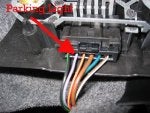OK - this wiring setup won't work for what you have in mind. It is used by aftermarket alarms for interfacing to the parking lights - it does the opposite to what you want (you want to supply power to something by turning on the parking lights - this setup will turn on the parking lights via a remote switch aka the parking light output of an aftermarket alarm). I know because this is exactly what I did to get my lights to flash with my alarm setup.
What you need to do is provide power to your halos when you turn on your parking lights (so I understand).
The BMW light module has a lot going on inside. Each individual exterior bulb on the car has its own power wire coming from that module - it isn't like older designs where there was one switched wire coming out of the switch which would be split out to all the bulbs in that switched circuit (in this case, the parking lights). The individual power wire design is done for the most part so the lighting computer can determine the load at each bulb location and tell you if there is a blown bulb at that location - with the split method, it wouldn't be able to do that.
The best way to wire your halos is to locate one of the power wires for a front parking light (say, the left one) and tap into it. However if you put too much of a load on the wire, the computer will think there is a problem and will trip the "bulb out" display for that location.
So instead of wiring directly to that power circuit, you will use a relay (the same one as in that diagram you posted) which will provide a power circuit for the halo.
Terminal 86 would go to ground. Terminal 85 would go to the parking light wire (to activate the relay). Terminal 30 would go to your halo power feed, and terminal 87 (not 87A) would go to live 12 volts (through a fuse).
The relay draws little current so it "should" not trip the bulb-out indicator. If it does, then you may need to try one of the other parking light feeds and see if the computer is less sensitive to impedance change at the new location.
Does any of this help?
Mark
PS: See the bottom of that diagram for appropriate disclaimers!










